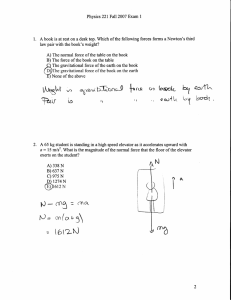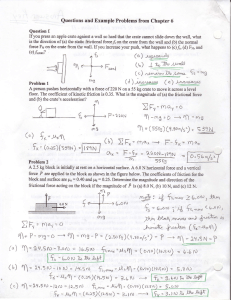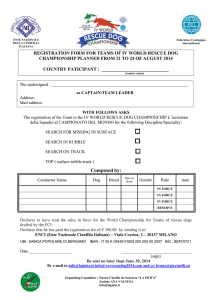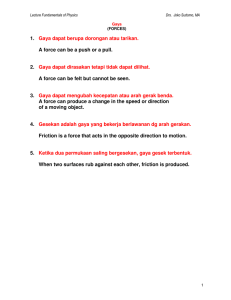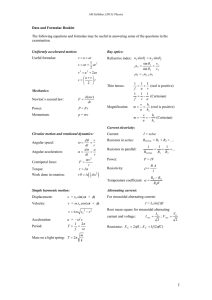Last class… Work and Energy Conservative vs. Non
advertisement
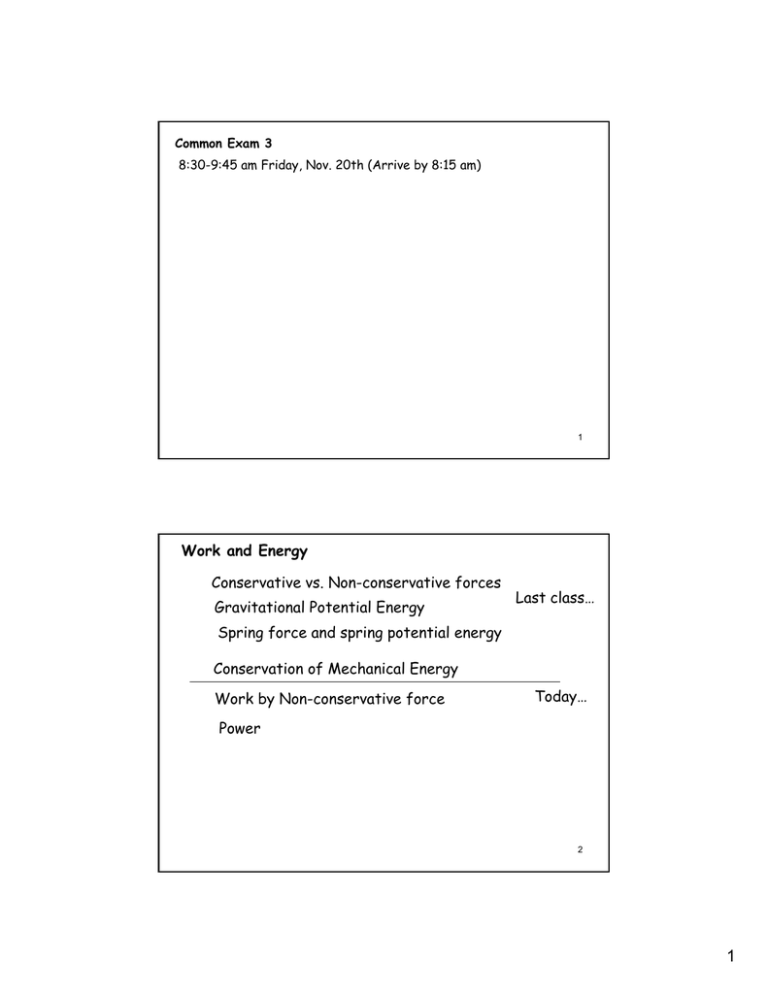
Common Exam 3 8:30-9:45 am Friday, Nov. 20th (Arrive by 8:15 am) 1 Work and Energy Conservative vs. Non-conservative forces Gravitational Potential Energy Last class… Spring force and spring potential energy Conservation of Mechanical Energy Work by Non-conservative force Today… Power 2 1 Work done on a system by non non-conservative force What if non-conservative forces do work on an object, in addition to conservative force? Non-conservative force: friction force, tension, force from a hand, … Example: Surface with friction Normal force Friction force Displacement Gravitational force First, let’s review sliding on surface without friction Normal force v1 Height Displacement h1 h2 0 Gravitational force Emech ,1 = Emech ,2 Æ v2 Æ 1 1 mgh1 + mv12 = mgh2 + mv22 2 2 Emech ,2 − Emech ,1 = ΔEmech = 0 2 Now, with friction…… Normal force Height Friction force v1 Displ Displacement m nt h1 h2 Gravitational force 0 v2 v2 with friction is smaller than Æ Emech ,2 v2 without friction. − Emech ,1 = ΔEmech ≠ 0 Relation between ΔEmech & friction force? Generally, ΔEmech = Wnon −conservative Æ Mechanical energy changes ΔEmech = W friction (see text for proof) Work done on a system by non non-conservative force If non-conservative forces do work on an object, in addition to conservative force, Æ Mechanical energy changes b th by the amount m nt of f work k done d n by b the th non-conservative n n ns ti f force. ΔEmech = Emech, f − Emech ,i = Wnon −conservative Emech = K + U 3 Example: Surface with friction K1 = 45 J Displacement = 2 m K2 = ? 30o Mass of the dog = 10 kg Friction force = 10 N Find the final kinetic energy, K2. Thermal energy and Work done by friction force Mechanical energy is reduced by friction force. Where has this mechanical energy gone? Observation : Friction heats up the object and the surface Some Mechanical Energy is converted to Thermal Energy ΔEthermal = W friction = −W friction = −ΔEmech ΔEthermal + ΔEmech = 0 Æ Etotal = Emech + Ethermal is conserved. Total energy of the whole system, dog + surface, is conserved. 4 Many types of energy Mechanical energy, thermal energy, chemical energy, light energy, electric energy, magnetic energy,……… General principle of Conservation of Energy Total energy of an isolated system is conserved. (in 1D) In 2D & 3D, Power: r r = F v cos θ F ,v 10 5 Work done by a force r r r r W = F d cos θ F ,d ≡ F ⋅ d Force θ Di l Displacement t Power done by a force r r r r P = F v cos θ F ,v ≡ F ⋅ v Force θ Velocity 11 Example Killer whales are known to accelerate very fast. Calculate the average power a killer whale with mass 8000 kg would need to generate to reach a speed of 12.0 m/s from rest in 6.0 s. Assume water resistance is negligible. 12 6
